by Steve Selden | May 11, 2017 | Conservation

President Donald Trump signs an order along with Sen. Lisa Murkowski, R-Alaska, right, on, April 28, 2017. The Executive Order gives the Interior Department directions to review restrictive drilling policies for the outer-continental shelf. Associated Press photo.
Alaska continues to fight to preserve the wild spaces that give the state its incredible natural character. A number of Alaska environmental and Native groups filed a lawsuit against the federal government challenging President Donald Trump’s executive order attempting to reverse regulations that restrict and ban oil and gas drilling, inland and offshore of Alaska’s Arctic.
Natural Resources Defense Council, Earthjustice, The League of Conservation Voters and other green agencies jointly filed the complaint in Alaska’s federal district court last week after Trump’s April 28th order, signed amid members of Alaska’s congressional delegation. The crux of the filing was that President Trump’s order exceeded authority under federal law.
Prior to the new administration taking office, then-President Barack Obama signed into law the Outer Continental Shelf Lands Act designating areas of the Arctic and Atlantic oceans off limits to oil and gas drilling.
The contending environmental groups argue that Trump’s action is illegal since Obama’s enacted law doesn’t have a provision explicitly allowing the order to be reversed.
Trump’s “executive order attempting to undo President Obama’s historic protection of the Arctic and Atlantic oceans from drilling is part of a plan to sell off our oceans to polluting corporations at the cost of the safety of coastal communities, the fate of marine wildlife and our children’s future,” said Earthjustice president Trip Van Noppen.
“These areas have been permanently protected from the dangers of oil and gas development. President Trump may wish to undo that, and declare our coasts open for business to dirty energy companies, but he simply lacks the authority to do so under the law,” said Niel Lawrence, NRDC senior attorney.
Trump’s “executive order attempting to undo President Obama’s historic protection of the Arctic and Atlantic oceans from drilling is part of a plan to sell off our oceans to polluting corporations at the cost of the safety of coastal communities, the fate of marine wildlife and our children’s future,” said Earthjustice president Trip Van Noppen.
Many other entities are involved in the lawsuit including Alaska Wilderness League, Sierra Club, Greenpeace and the Wilderness Society along with a handful of smaller local groups.
In a statement released by The Arctic Energy Center, an oil industry affiliate, rationale behind the lawsuit was challenged.
“There’s no precedent to show a ban should be permanent, there is nothing to suggest a subsequent White House cannot overturn the decision, and that the last administration’s application of the rule conflicts with the act’s wider specification to ensure (the Outer Continental Shelf) is ‘available for expeditious and orderly development,’ ” stated spokesman Oliver Williams.
by Steve Selden | May 5, 2017 | Conservation
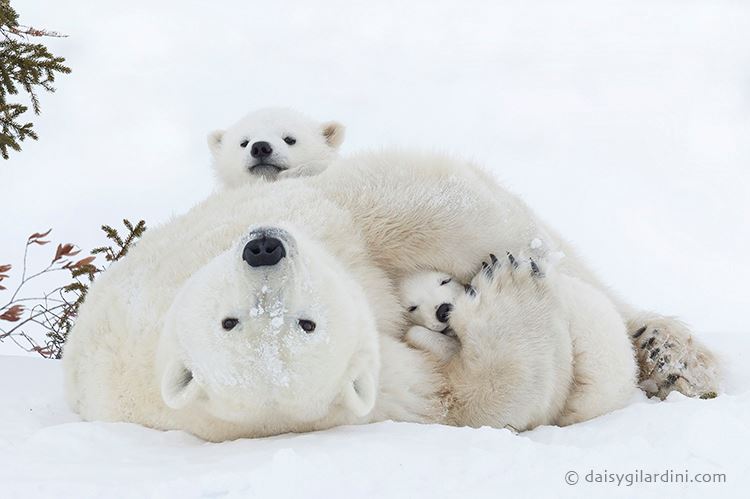
Polar bear habitat protection is becoming a hot issue. Daisy Gilardini photo.
The U.S. Supreme Court stood up against a coalition of organizations within Alaska by declining to hear a case on Monday which attempts to repeal the previous federal government administration’s policy to designate more than 187,000 square miles of Alaskan wilderness as critical habitat for threatened polar bears.
Lawsuits filed against the Interior Department by the Alaska Oil and Gas Association and the state of Alaska along with Native corporations and local governments were able to reverse the regulation in 2013 though the 9th Circuit Court of Appeals reversed that ruling.The state of Alaska and the Alaska Oil and Gas Association — joined by Native corporations and local governments — brought lawsuits against the Interior Department to overturn that decision.
However, the U.S. Supreme Court decided against hearing the case and therefore the ruling reverted back to the original law which was instituted by the U.S. Fish and Wildlife Service. The area in Alaska’s Arctic was protected by the federal government in December 2010.
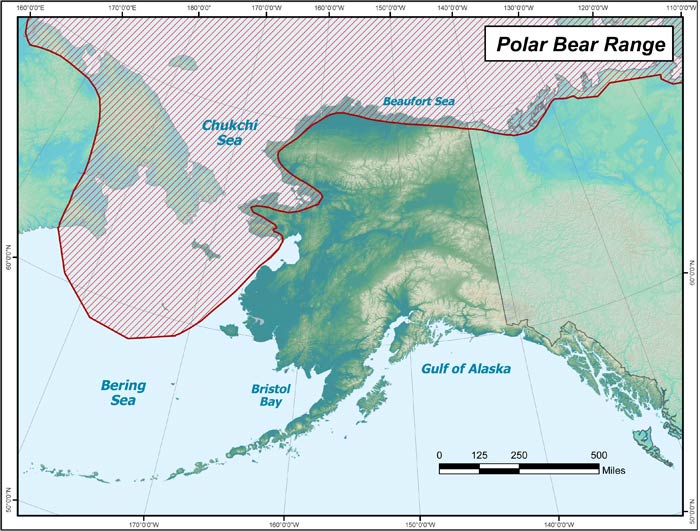
Alska polar bear habitat. State of Alaska photo.
Opposition groups filing appeals against the original designation claimed that the Fish and Wildlife Service overstepped its authority and created major economical consequences with relatively no conservation benefit whatsoever. The argument presented to the Supreme court attempted to overturn the decision by the 9th U.S. Circuit Court of Appeals which left Fish and Wildlife open to make “sweeping designations (in this case an area the size of California) that overlap with existing human development (including, even, industrial areas).” further arguing that the designated polar bear habitat interfered with oil industry operations as well as tribal sovereignty.

Mother polar bears avoid having their cubs swim in the ocean until they have the fat reserves to protect them. Jonathan Hayward photo.
“Swept within that enormous block of land are the entire ancestral homelands for certain Native communities, as well as the largest and most productive oil field in North America,” the petition to the oil and gas group gave the Supreme Court. Nearly 96 percent of the protected habitat area is sea ice, the smaller, remaining area includes “industrial facilities, garbage dumps, airports, communities, and homes (from which bears are actively chased away) as ‘critical’ habitat that is purportedly free from ‘human disturbance’ or otherwise ‘unobstructed,’ ” the petition said.
The coalition of various groups argued further that the 9th Circuit Court’s broad ruling would allow for expansion of habitat designations in other regions of the United States.
The government stated that it utilized two rounds of public comment and current, leading scientific data in defense of why the protected habitat was designated by courts initially.
“The Service did not designate any areas outside the geographical area currently occupied by polar bears because it determined that ‘occupied areas are sufficient for the conservation of polar bears in the United States,’ ” the federal government reported to the Supreme Court.
by Steve Selden | May 2, 2017 | Conservation

Researchers are seeing melting glaciers and declining sea ice in the Arctic. Getty Photo.
Some scientists believe the best adjective to characterize the Arctic is “unravelling”!
According to some data, the region is warming more than twice as fast as the rest of the Earth’s regions according to findings by a team comprised of over 90 researchers. Declining sea ice and receding glaciers have been noted consistently over the last decade and the team has confirmed the continuation of these processes.
Warming in the Arctic has increased more rapidly between 2011 and 2015 since 1900 when the first climate records were registered. Snow cover in the region has also decreased by 50% further confirming the rise in temperatures over the years.
A major resulting affect from the warming will be global sea levels rising faster than predicted. Estimates of 2013 by an intergovernmental panel estimate levels rising twice as much as previously thought.
The Arctic Monitoring and Assessment Programme, in their most recent publication of Snow, Water, Ice and Permafrost in the Arctic report the findings in line with what the scientists are finding all across the Arctic.
“The Arctic that you will have by mid-century will be very different from the Arctic that we see today,” said Morten Skovgård Olsen, who coordinated the research.
by Steve Selden | Apr 17, 2017 | Conservation
Mario Tama photographed these breathless Arctic photos from a Lockheed P-3 accompanying a NASA crew carrying out Operation Icebridge, an operation initiated to measure Earth’s glaciers and ice sheets. The stillness, colors and textures of the Arctic landscape left Tama speechless.
“It’s such an unexpected landscape,” he says. “It felt like we were flying over a different planet.”
NASA spends 10 weeks each spring in the Arctic when the ice levels are at their highest using a pair of laser altimeters to record ice elevation and three types of radars to measure snow – one of which reaches 300 feet down to bedrock. Flying shifts of up to 12 hours, the crew surveyed hundreds of miles of coastline along Ellesmere Island in Canada and Greenland. While researchers focused on computer screens, Tama focused his camera on a landscape without scale.
“I was looking at shapes and features that I had never seen in my life,” Tama says. “We’d drop through the clouds or take a turn into a valley, and I’d be sitting there trying to process, what am I looking at?”
Last year the National Snow and Ice Data Center NASA and operation IceBridge announced the lowest ice levels for the Arctic and Antarctic in the past 38 years.
“Changes in Arctic sea ice is seen as one of the primary indicators of climate change,” says Nathan Kurtz, project scientist for Operation IceBridge. “It’s been changing so rapidly—the Arctic has been changing and warming. What we’re trying to do is get a sense of what’s driving some of the bigger changes that we’re seeing.”
Tama’s stunning images remind us all of the majestic beauty of the north that is in jeopardy due to global warming!
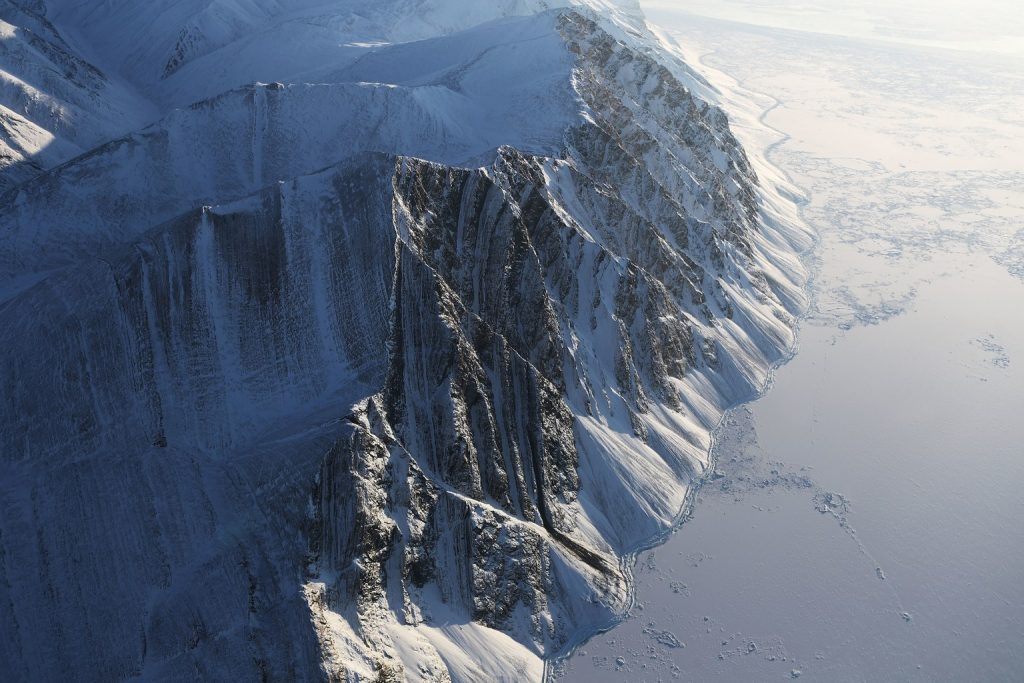
Ellesmere Island ice field. NASA photo.

Ice pack near Ellesmere Island. NASA photo.

Ice along the Baffin Island coast Greenland. NASA photo.

NASA avionics technician surveys the Arctic landscape. NASA photo.
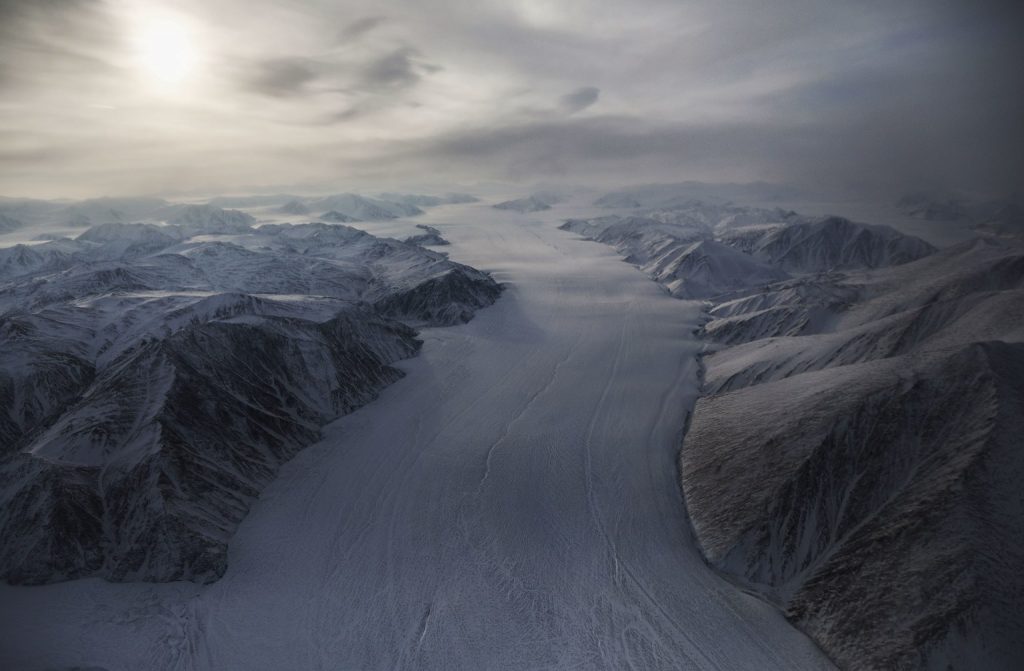
Glacier on Ellesmere Island. NASA photo.
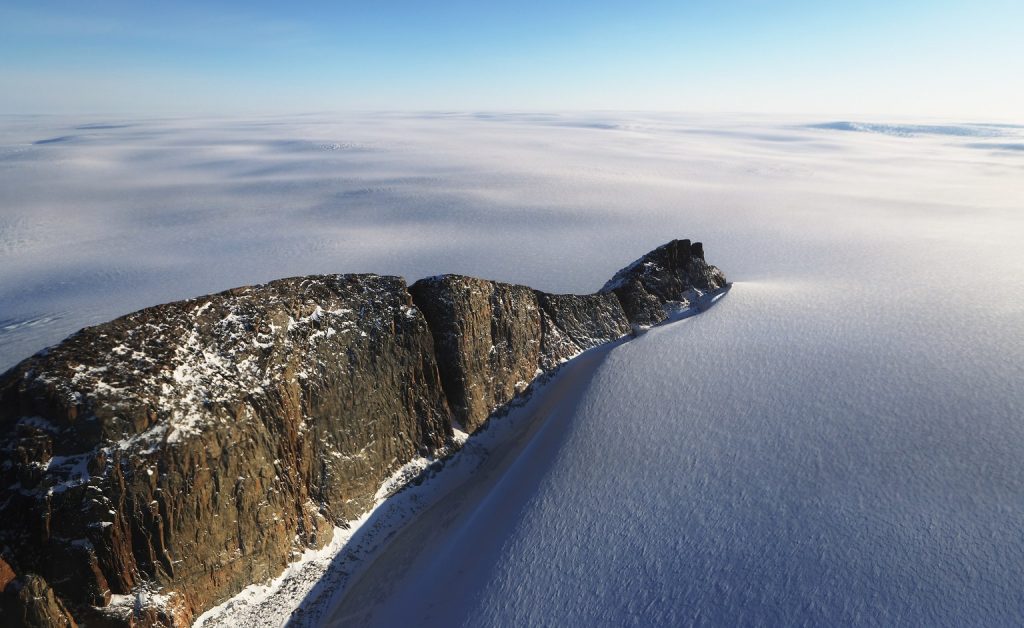
Baffin coast ice field Greenland. NASA photo.
by Steve Selden | Apr 4, 2017 | Conservation
People on Bell Island of Newfoundland and Labrador have united to rescue a pod of dolphins stuck in thick pack ice since Sunday. In all, the group of islanders successfully rescued four dolphins by Monday.
“It was amazing to see a community come together to help these animals out,” said Jim Bennett, who was one of several people trying to help the stranded mammals.

Dolphins trapped in ice off Bell Island. Christopher Kitchen photo.
The Whale Release and Stranding’s Group initiated their effort at daybreak and worked tirelessly throughout the day. However, as with many stranding’s of this sort, casualties are part of the deal. Five of the dolphins died due to the extreme conditions – four were crushed by the ice and one didn’t survive transport to the release site.
After resident Lisa Gear posted a picture of the dolphins on her Facebook page depicting the dolphins nearly frozen into the ice, rescuers responded and had to work out some logistics and methods for moving the dolphins to safe water. After first using a sled to try and move them, a tarpaulin sling was eventually used for transport of the fragile beings.
An extension ladder was used to save one of the dolphins out farther in the ice. Walking past a few of the already expired dolphins was “surreal” for Jim Bennett. Working their way out to the animal allowed them to get a rope around it and guide it in.

A dolphin gets love and attention from Bell Island rescuers. Christopher Kitchen photo.
“[The dolphin] looked like it was on its last legs and all the community were hanging on to the rope by the shore and they pulled it in,” recalled Bennett, who said he is from Ontario.
“I was completely impressed how people came together in crisis down by the water. This could only happen in Newfoundland. It was really great.”, stated Bennett.
The surviving dolphins were bleeding from their ice – scraped skin layer. While the injured dolphins were attended to some Bell Island citizens brought thawed capelin and herring to feed the animals.
“We were told that to just leave them alone but, as animals ourselves, it just didn’t make sense to just let them perish.” added Bennett. For now the survivors look good and energized.
by Steve Selden | Apr 3, 2017 | Conservation
Recently we reported on the deposit of 50,000 seeds into the “Doomsday Vault” on Svalbard Island in Norway. The vault is buried in the side of a snow packed mountainside and sealed to preserve the precious seeds that produce Earth’s food supply. In case of a catastrophic event jeopardizing our most fruitful plants and vegetables, these seeds are stored safely and can remain usable for nearly two centuries. The consistent cool temperatures resulting from the surrounding permafrost act as a built in refrigeration system.
Now, another similar storage system on the same island, Svalbard, is serving to protect the massive information files for humanity. The new “Digital Doomsday Vault” or Arctic World Archive, managed by Norwegian company Piql as well as a Norwegian coal mining company, will store data transferred to film for 1,000 years or more.

Global Doomsday seed vault on Svalbard Island. Global Crop Diversity Trust photo.
National Archives of Mexico and the National Archives of Brazil have sent data so far to be stored in the vault.The Brazilian constitution was one of the documents sent though the storage facility is open to any and all historic documents states Piql.
All data processed by Piql will be formatted to photosensitive film which is impossible to delete or manipulate and is able to resist heavy wear and tear. When data is stored in analog form the contents is protected from remote alteration or cyber attacks of any kind. Considered more future proof than digital, analog requires no special updates or codecs to read the information if some rest of catastrophic degree were to occur. As long as internet servers are functional all data will remain accessible online and digitally delivered or shipped by request of a user.
These film reels will be stored deep inside a permafrost encased abandoned mine with a consistent temperature of 0 degrees Celsius.

Photographers stationed outside the “Doomsday” seed vault in Svalbard at its opening in 2008. (AP Photo/John McConnico)
Having both the “Doomsday” seed vault and now, the “Doomsday” data vault on the same island, Svalbard, opens up discussion from critics on ease of terrorism or natural disaster implications. With the widespread and multi – level destabilization in our world today, these precious archives will help humans piece together a cultural puzzle should a catastrophe of mass proportions destroy large amounts of data.
















